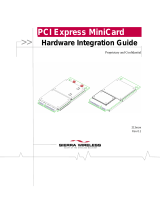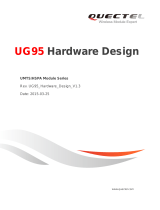
AirPrime Embedded Module Hardware Integration Guide
10 Proprietary and Confidential 2130114
MC5728V Mini Card Product Specification
(Document 2111350)
Features, mechanical and electrical specifications, and standards
compliance of the MC5728V.
MC8201 PCI Express Mini Card Product
Specification (Document 2131362)
Features, mechanical and electrical specifications, and standards
compliance of the MC8201.
MC8700 PCI Express Mini Card Product
Specification (Document 2131202)
Features, mechanical and electrical specifications, and standards
compliance of the MC8700.
AirPrime MC8704 with Audio PCI Express
Mini Card Product Specification (Document
2400059)
Features, mechanical and electrical specifications, and standards
compliance of the MC8704.
AirPrime MC8705 PCI Express Mini Card
Product Specification (Document 2400057)
Features, mechanical and electrical specifications, and standards
compliance of the MC8705.
MC8775 PCI Express Mini Card Product
Specification (Document 2130697)
Features, mechanical and electrical specifications, and standards
compliance of the MC8775.
MC8775V with Audio PCI Express Mini Card
Product Specification (Document 2130700)
Features, mechanical and electrical specifications, and standards
compliance of the MC8775V.
MC8780 / MC8781 PCI Express Mini Card
Product Specification (Document 2130782)
Features, mechanical and electrical specifications, and standards
compliance of the MC8780/MC8781.
MC8790 PCI Express Mini Card Product
Specification (Document 2111279)
Features, mechanical and electrical specifications, and standards
compliance of the MC8790.
MC8790V PCI Express Mini Card Product
Specification (Document 2111280)
Features, mechanical and electrical specifications, and standards
compliance of the MC8790V.
MC8791V PCI Express Mini Card Product
Specification (Document 2131032)
Features, mechanical and electrical specifications, and standards
compliance of the MC8791V.
MC8792V PCI Express Mini Card Product
Specification (Document 2131033)
Features, mechanical and electrical specifications, and standards
compliance of the MC8792V.
MC8795V PCI Express Mini Card Product
Specification (Document 2131276)
Features, mechanical and electrical specifications, and standards
compliance of the MC8795V.
MC87XX Modem CnS Reference (Document
2130602)
CnS (Control and Status) messages supported by AirPrime UMTS
embedded modules.
MC87xx Modem CnS Reference (Voice)
(Document 2130817)
Voice-related CnS (Control and Status) messages supported by voice-
enabled AirPrime UMTS embedded modules (MC8704, MC8775V,
MC8790V, MC8791V, MC8792V, and MC8795V).
AirPrime MC8801 PCI Express Mini Card
Product Specification (Document 2400068)
Features, mechanical and electrical specifications, and standards
compliance of the MC8801.
AirCard/AirPrime UMTS devices Supported
AT Command Reference (Document
2130617)
Proprietary, basic AT commands for UMTS AirCard and AirPrime
devices. For CDMA-specific commands, see the CDMA AT Command
Reference (Document 2130620).
AirPrime MC8xxx Embedded Modules
Extended AT Command Reference
(Document 2130616)
Proprietary AT commands for UMTS AirPrime embedded modules. For
CDMA-specific commands, see the CDMA Extended AT Command
Reference (Document 2130621).
Table 1-2: Related documentation (Continued)
Document title Description






















